

|
Friday, November 10 Breakfast is at 7. The whiteboard over the kitchen’s serving counter shows the sunrise and sunset times (7:56 a.m., 4:04 p.m.) and the day’s forecast: high -9 C, low -20 C (16 F, -4 F). Good news: The wind has shifted and is blowing the ice offshore. Many bears have already left, on that first ice, but any that didn’t are stuck here until there’s again ice close to shore. And we might see them. Many of us had a chilly night. There’s no heat in the rooms, just from the hall, so with door closed, heat quickly leaked out the window. We have cozy warm comforters, folded in half like a sleeping bag, but the window and aluminum sill were really cold, if you happened to touch them. Nancy laid one of the thin fleece blankets over the sill; two mornings later it would be frozen to the window. Several of us got smart after last night and remade our beds with the comforter opening away from the window, instead of towards it. And later we all learned, to great hilarity, that at least 2 of our group didn’t realize they could crawl into the comforter and instead slept on top of it, trying unsuccessfully to stay warm with the 2 fleece blankets plus their parkas and whatever other clothes they could drape over themselves. Yesterday everyone signed up for either morning or afternoon rover tours. Today we have the afternoon, so after breakfast, we have free time. Showers are only allowed after the rover leaves in the morning until before it returns late afternoon, so all of our group takes turns in the showers. At about 10, we gather in the lounge for another presentation from Eddy. We learn about the Arctic, tundra, and permafrost. Turns out permafrost is really interesting. Its thickness ranges from a few feet to thousands of feet thick. On top the permafrost is a layer that freezes and thaws annually, which can be a few inches to a few feet. That’s the only place plants can grow. But because the average temperature is so cold, plants don’t decompose, and the soil in that active layer is very poor. So it’s not just the short growing season (about 60 days here) that causes plants to struggle. The few midget white spruce we saw yesterday might be 150 years old but only 4" in diameter. They don’t even produce cones. They reproduce when branches are laid down by the snow and eventually root. We are already eating lunch when the morning group returns, excited but sworn to secrecy by Bonnie. We put on boots (a 5-minute process) and parkas and head for the rover. We’re off to find bears! With only 14 in our rover group, we each have a window and an
empty seat for our backpacks and parkas. Dianne wants to be the first
person onto the deck when a bear is spotted, so she takes the last row.
Giselle and Nancy are in the rows in front of her. |
|
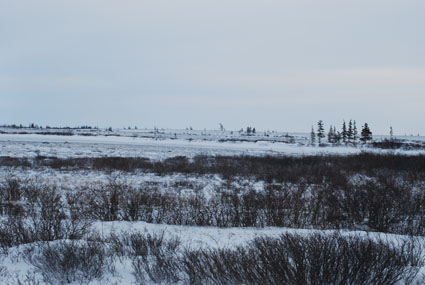 |
|
|
After bouncing through the tundra for a while, we spot our first
bear of the day! |
|
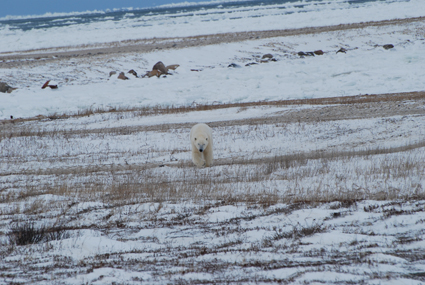 |
|
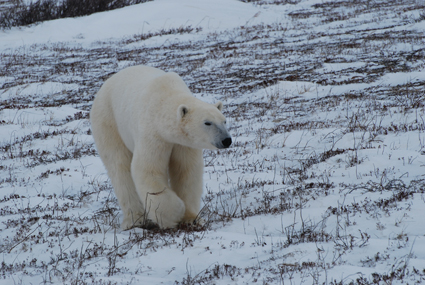 |
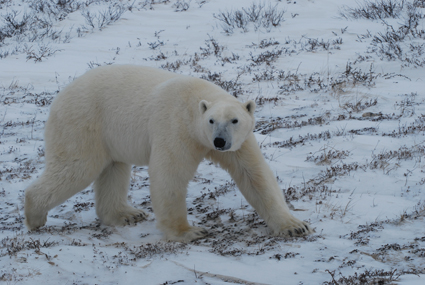 |
|
He ambles to the rover (we never see a bear move quickly), strolls up
and down its length, sniffs, rises, tastes the tires, and just generally
thoroughly investigates. |
|
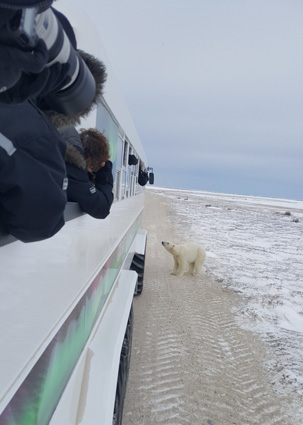 Recognize Dianne? She got the prime photographing spot -- the advantage of the back row! photo courtesy of Eddy Savage |
|
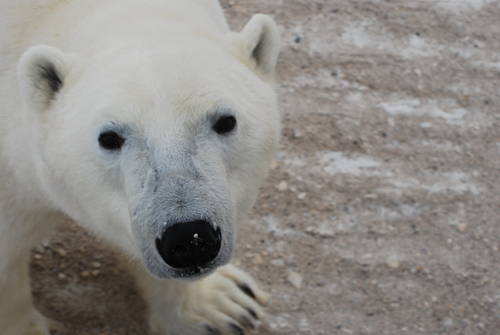 He got even closer than this. So close in fact, the telephoto lens couldn't focus on him when he stood up for a better look at us. |
|
|
We have been warned that when a bear is close, we should be as quiet as possible. No talking, no window or door noise, no lens caps clinking. Yesterday, when we saw the snoozing bear, we were really noisy. Today, with the bear right beside us, we are almost reverently quiet. In videos, all you can hear are wind and clicking cameras. We are face-to-face with, sometimes less than a yard away from, a clearly intelligent, curious creature in a world and life of his own. We are just visitors. He belongs here. Dianne is on the deck, snapping away. Nancy grabs the little camera, which has video, starts shooting out her window, and just keeps it running for 8 minutes. Click here to watch a shortened video of the curious bear. (If you watch it, towards the end it looks as though the bear could bite someone’s elbow. That’s an illusion caused by perspective and telephoto. Those people are on the back deck, well above the bear’s reach.) |
|
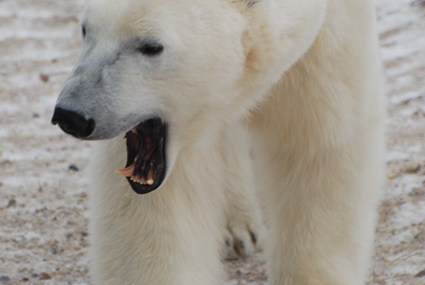 He yawned and showed us his nice big teeth |
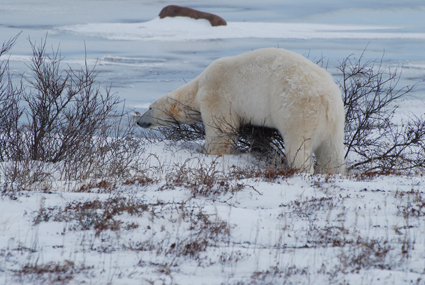 Then he needed a tummy rub |
| After 10 or 15 minutes, the bear wanders away. He scratches an itch on some willows, then crosses a frozen pond and starts playing in the snow bank. He pounces on a spot, dives head-first into the spot, puts his butt in the air, turns somersaults, gets up and does it again and again. What is he after? Mice or lemmings? Just playing? After a while he sprawls full length in the snow, rolls belly-up, wiggles around, slides down the hill. Finally, 45 minutes after we first spotted him, he ambles off. We are charmed, awed, and excited. | |
|
Watch a slideshow
of this bear's antics. |
|
|
The rover moves again. To us it feels as though we’re just roaming
around on the tundra, but Jason always knows exactly where he is and
where he’s headed. Eddy starts talking about kelp. Kelp will become a
running joke among our group. Eddy soon gets interrupted by something
more interesting outside the rover. Next time we get moving, he starts
in on kelp again. Interrupted again. Next opportunity, "Back to kelp."
It took a lot of interrupted starts for him to make it all the way
through the bit about kelp. Which is: Polar bears sometimes feed in
piles of kelp that wash up on shore. This is a mystery, because polar
bears are carnivores and can’t digest kelp. So why do some bears (not
all) eat kelp? Maybe it has nutrients they’re missing. Maybe it helps
their digestive tract get moving after a summer of fasting. Maybe some
other reason scientist have yet to learn. A few minutes later, Eddy nonchalantly says, "We might be coming up on something. You might want to put on your parkas and open your windows." Of course, he and Jason know exactly what the morning group has seen and where, plus they’re in radio contact with other Polar Rover and Tundra Buggy drivers, so they know what’s being reported now. There’s a mad scramble as we all put on parkas, hats, and gloves and open windows. Cameras and binoculars are already out, of course. Soon we stop. Across a frozen pond are a mother bear and two cubs. We are beyond excited. |
|
 This is what the telephoto lens saw. |
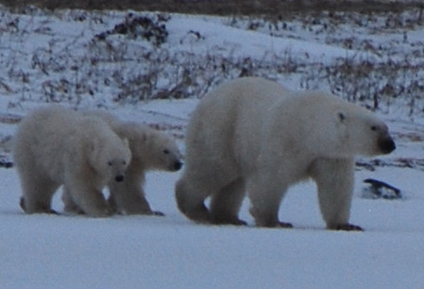 This is zooming in on the same picture. |
| The family stroll toward us and stop in a pile of — kelp! For the next hour we watch them. They mess around in the kelp for 15 minutes, mama getting her nose filthy, pouncing into the kelp, and cubs trying to imitate mama. | |
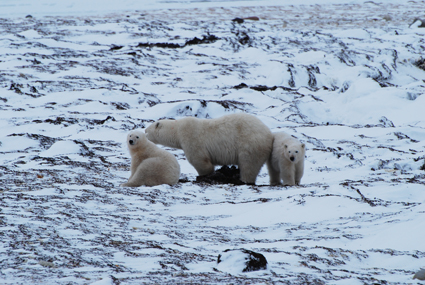 |
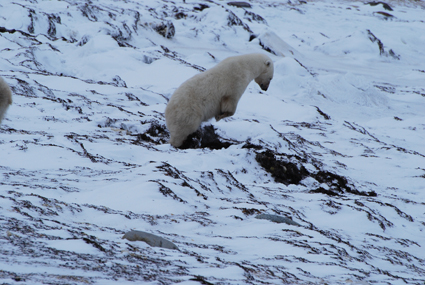 |
| Then they stroll over to the rover and investigate us for a few minutes, before heading back across the pond. | |
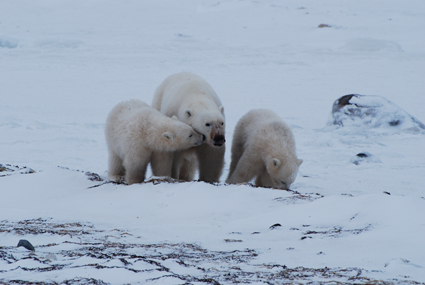 |
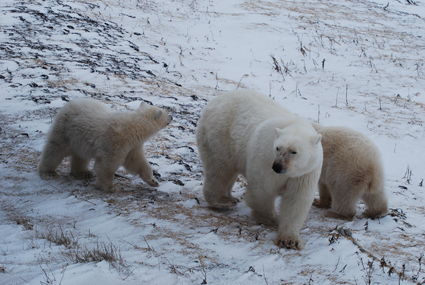 |
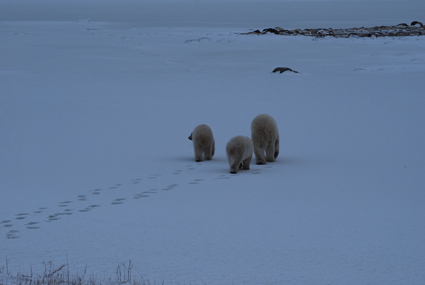 |
|
|
Jason starts up the rover and moves off, as Eddy
tries to lecture about kelp. Soon it becomes clear that Jason is
circling around to intercept the family. We park beyond their path, and
they come right up to the rover again. Dianne, as usual, is out on the
back deck. Nancy is standing beside Jason’s seat when the family comes
up the left side of the vehicle. "Here, sit in my seat," Jason
says. Nancy leans into his open window as a cub rises up, chuffing
softly. Wow. |
|
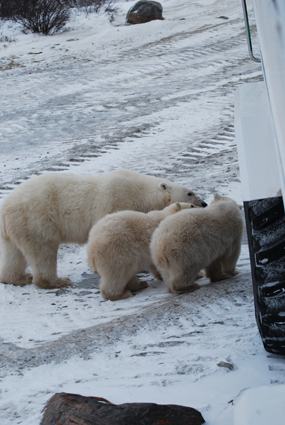 |
|
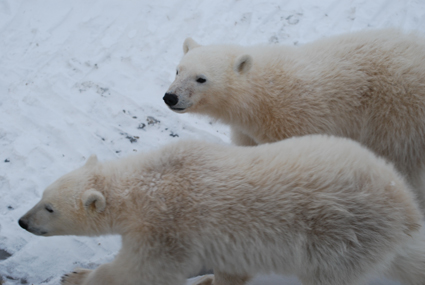 |
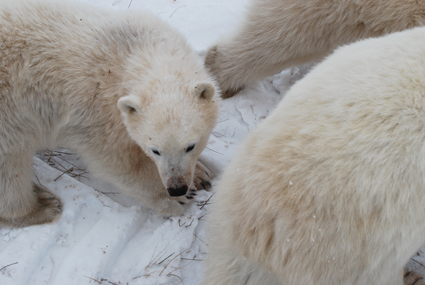 |
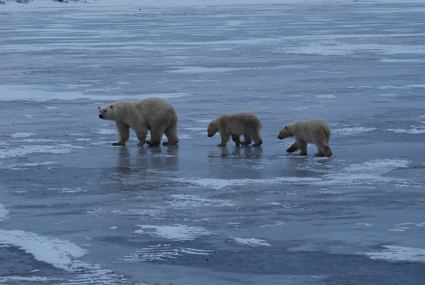 |
|
|
Mama and cubs meander off across the ice. We are overjoyed: we came to Churchill to see polar bears, and we have had two awesome experiences. On the way back to the Tundra Lodge, Eddy brings out his favorite prop, a synthetic polar bear skull, which we examine to understand how these bears are built for their lifestyle. For example, they have a huge area devoted to nose and enormous teeth for locking onto a seal. |
|
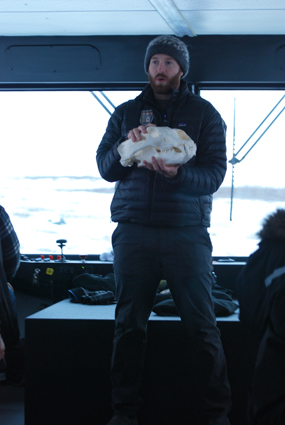 |
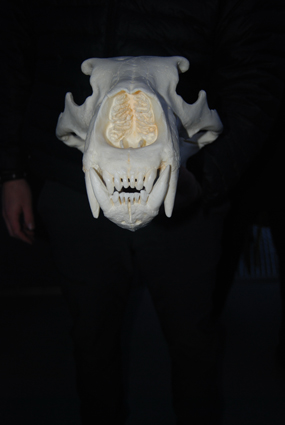 |
|
We reach the lodge as the sun is setting. We compare experiences with the morning group, who saw the same mother and cubs. Eddy and Bonnie didn’t want to tell us, in case we didn’t see them and also to maintain the element of surprise. After another delicious dinner, Eddy finally gets to present Polar Bears 101. How do these bears live, and why are they here? We knew much of this from books we read before our trip. Forget what you know about black and grizzly bears – berries, grubbing, hibernating all winter. Polar bears are completely different. Their primary diet is ringed seals. Although they swim (they’re classified as a marine mammal), they hunt from atop the ice, waiting patiently beside a seal’s air hole for hours until it surfaces. They spend all winter out on the ice, eating and gaining weight. When the ice thaws in late spring or early summer, they come onto the land. They spend the summer lazing around, trying to stay cool, not eating much. By November, they’ve lost up to 400 pounds and are hungry and eager to get on the ice. The bears we’re seeing are all skinny. Pregnant females dig a den instead of going onto the ice. They give birth in December, bring the cubs out in about March, and soon take them out on the ice. The cubs we saw were COYs, cubs of the year, so they are almost a year old. They're still nursing, so they're not hungry. Why here? We’re on a spit of land jutting north into Hudson Bay, southeast of Churchill. North of town the wide Churchill River flows into the bay, bringing fresh water and making the bay just a bit less salty than anywhere else. The water of Hudson Bay circulates slowly counterclockwise, so that water moves past town and toward this spit. Salt lowers the freezing point of water, so the less salty water around here freezes before the rest of the bay. And the bears know that. By waiting here, they can catch the first ice floes out. But with a warming world, the bears are in trouble. The ice freezes later and melts earlier. The bears have a month less to fatten up on the ice and a month more to wait on land. The stress is taking its toll. In the 1980s and 1990s, there were about 1200 bears; now there are 800. Churchill reached an unbelievable 90 F last summer. Red foxes are moving north and killing Arctic foxes. Bonnie has seen cones on white spruces. And grizzlies have moved north and mated with polar bears. (Pizzlies? Grolars?) The world is changing faster than animals can adapt. Scientists don’t know whether the polar bears will survive another 20 years. We go to bed on a grim note. Tonight Bonnie and Eddy take turns waking up every hour and checking for the aurora borealis. Sometime in the middle of the night, there’s a knocking on our doors and Bonnie’s voice; "There’s an aurora! But you can see it from your beds." We looked, we saw, we slept. |
|
|
Continue the journey - day 3 at Churchill Return to Long Shadows Home Page |
|